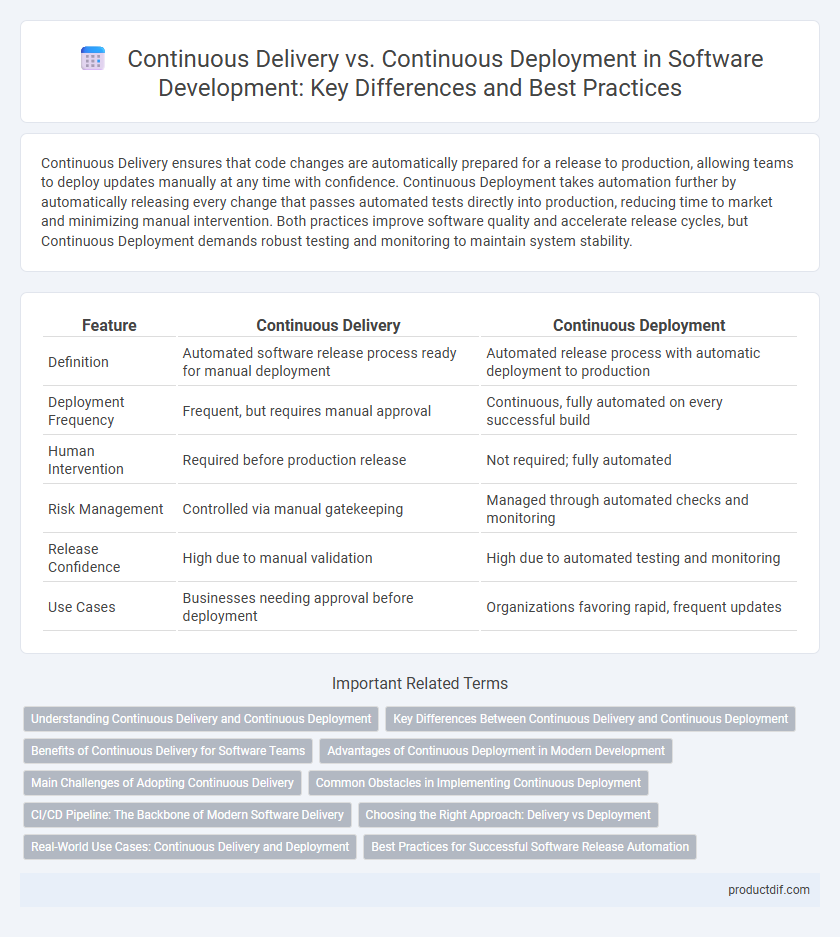Continuous Delivery ensures that code changes are automatically prepared for a release to production, allowing teams to deploy updates manually at any time with confidence. Continuous Deployment takes automation further by automatically releasing every change that passes automated tests directly into production, reducing time to market and minimizing manual intervention. Both practices improve software quality and accelerate release cycles, but Continuous Deployment demands robust testing and monitoring to maintain system stability.
Table of Comparison
| Feature | Continuous Delivery | Continuous Deployment |
|---|---|---|
| Definition | Automated software release process ready for manual deployment | Automated release process with automatic deployment to production |
| Deployment Frequency | Frequent, but requires manual approval | Continuous, fully automated on every successful build |
| Human Intervention | Required before production release | Not required; fully automated |
| Risk Management | Controlled via manual gatekeeping | Managed through automated checks and monitoring |
| Release Confidence | High due to manual validation | High due to automated testing and monitoring |
| Use Cases | Businesses needing approval before deployment | Organizations favoring rapid, frequent updates |
Understanding Continuous Delivery and Continuous Deployment
Continuous Delivery ensures that code changes are automatically tested and prepared for release, allowing development teams to deploy updates to production manually at any time. Continuous Deployment extends this process by automatically releasing every change that passes all tests directly into production without manual intervention, enabling faster delivery cycles. Both practices rely heavily on automated testing, integration pipelines, and monitoring tools to maintain code quality and system stability.
Key Differences Between Continuous Delivery and Continuous Deployment
Continuous Delivery ensures that code changes are automatically prepared for release to production, requiring manual approval before deployment, whereas Continuous Deployment automates the entire release process, deploying every change that passes automated tests directly to production. Key differences lie in the deployment automation level, with Continuous Delivery involving a manual release gate and Continuous Deployment lacking any manual intervention. These distinctions impact release frequency, risk management, and operational workflows in software development pipelines.
Benefits of Continuous Delivery for Software Teams
Continuous Delivery enhances software teams' efficiency by enabling faster and more reliable release cycles, reducing manual errors through automated testing and integration processes. It ensures consistent code quality and rapid feedback, allowing teams to detect and resolve issues early, which improves overall product stability. This practice fosters better collaboration between development and operations, streamlining deployments while maintaining control over when new features reach production.
Advantages of Continuous Deployment in Modern Development
Continuous Deployment accelerates the software release cycle by enabling automatic deployment of every code change that passes tests, reducing manual intervention and human error. It enhances feedback loops, allowing development teams to promptly detect and resolve issues, improving overall software quality and user satisfaction. Moreover, Continuous Deployment supports agile practices by fostering rapid iteration and innovation, ensuring faster delivery of valuable features to end-users.
Main Challenges of Adopting Continuous Delivery
Implementing Continuous Delivery presents key challenges such as maintaining a reliable and automated testing framework to ensure code quality at every stage. Organizations must also address cultural shifts towards frequent collaboration between development and operations teams to streamline deployment processes. Ensuring infrastructure scalability and robust monitoring systems is critical for managing frequent releases without impacting system stability.
Common Obstacles in Implementing Continuous Deployment
Common obstacles in implementing Continuous Deployment include integration complexities with existing legacy systems and ensuring reliable automated testing to prevent faulty releases. Insufficient cross-team collaboration and resistance to cultural changes hinder the seamless adoption of continuous deployment practices. Security concerns and the challenge of maintaining consistent monitoring and rollback mechanisms also pose significant barriers.
CI/CD Pipeline: The Backbone of Modern Software Delivery
Continuous Delivery ensures code changes are automatically built, tested, and prepared for release to production, enabling faster and reliable software updates. Continuous Deployment extends this process by automatically releasing every change that passes all stages of the CI/CD pipeline, eliminating manual intervention. Effective CI/CD pipelines integrate automated testing, version control, and deployment tools to streamline software delivery and improve operational efficiency.
Choosing the Right Approach: Delivery vs Deployment
Choosing between Continuous Delivery and Continuous Deployment depends on the organization's risk tolerance, release frequency, and automation maturity. Continuous Delivery ensures code changes are rigorously tested and ready for manual release, providing control over deployment timing and minimizing production risks. Continuous Deployment automates the entire release pipeline, promoting rapid delivery but requiring robust monitoring and rollback mechanisms to handle potential issues swiftly.
Real-World Use Cases: Continuous Delivery and Deployment
Continuous Delivery enables teams to push code changes to a staging environment for additional testing and approval, commonly used in enterprises requiring compliance verification before production release. Continuous Deployment automates the release process, allowing every change that passes automated tests to be deployed directly to production, often adopted by startups aiming for rapid feature iterations and immediate user feedback. Companies like Netflix use Continuous Deployment to deliver updates multiple times per day, while organizations in regulated industries prefer Continuous Delivery to maintain control over production releases.
Best Practices for Successful Software Release Automation
Automating software release processes through Continuous Delivery or Continuous Deployment significantly enhances release frequency and reliability by integrating automated testing, validation, and deployment pipelines. Key best practices include maintaining comprehensive version control, implementing robust automated test suites to ensure code quality, and establishing rollback mechanisms to quickly address deployment failures. Emphasizing collaboration between development and operations teams fosters continuous feedback, accelerating issue resolution and optimizing software release automation efficiency.
Continuous Delivery vs Continuous Deployment Infographic

 productdif.com
productdif.com